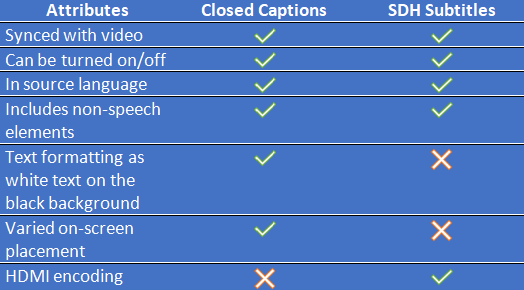One of the most common and confusing questions that often arise when we discuss media accessibility is: Are subtitles and closed captions the same? The growing media consumption and the rise of OTT channels have blurred the lines between the definitions of subtitles and closed captions. It is difficult to distinguish between the d/Deaf and hard of hearing (SDH) subtitles and closed captions.
Many media platforms offer SDH subtitles and closed captions, often confusing viewers. In the USA and Canada, subtitles of any form are intended for hearing viewers who cannot understand the language. However, in Europe, “subtitle” is an umbrella term to define both subtitles and closed captions.
In this blog, we will explain what SDH subtitles and closed captions are and discuss the critical differences between the two.
What are SDH subtitles?
Subtitles are transcribed words synchronized to the media files to ensure they play simultaneously with the video on the screen. There are two types of subtitles are – SDH and non-SDH. SDH abbreviates to subtitles for d/Deaf and hard of hearing. SDH subtitles are aimed at users who cannot hear the dialogues and thus include non-speech elements like speaker information, sound effects, and music. SDH subtitles provide a better experience for media consumers than the subtitles.
Some key terms to understand SDH subtitles are deaf, Deaf, and hard of hearing:
- Deaf in lowercase d refers to individuals with no hearing ability but can communicate orally.
- Deaf in uppercase D refers to members of the deaf community whose sole communication is sign language.
- Hard of hearing refers to individuals who experience hearing impairment, including those who require hearing aids.
- SDH can be translated into other languages too, enabling d/Deaf and hard-of-hearing audiences from different countries to experience the content.
- What is closed captioning?
- Closed captions are not restricted to the speech. Captions also include non-speech elements, such as sound effects, that are important to understand the video. Closed captions are usually identified by a CC icon on a video player.
- The history of captions dates to the 1970s, starting in 1972 with the regular use of open captions. The PBS show “The French Chef” was the first to incorporate open captions regularly. Open captioning eventually led to the development of closed captioning, which was first displayed in Nashville in 1971 at a conference for those with hearing loss. This was followed by a second demonstration in 1972 at Gallaudet University, where the National Bureau of Standards and ABC showcased closed captioning embedded in a broadcast of “The Mod Squad.”
- By 1979, the National Captioning Institute was founded, and in 1982, the institute developed a process of real-time captioning to enable captions in live broadcasting. The National Captioning Institute helped American television to begin the full-scale use of closed captions. “Masterpiece Theatre” on PBS and Disney’s “Son of Flubber” on NBC were two of the first programs to be seen with closed captioning.
- In 1990, the U.S. Congress passed the Television Decoder Circuitry Act, allowing the Federal Communications Commission to put rules in place for implementing closed captioning. The Television Decoder Circuitry Act was a big step in enabling equal opportunity for those with hearing impairments, as it was passed the same year as the Americans with Disabilities Act.
- Difference between SDH and closed captions
- Let’s examine some key differences between closed captions and SDH subtitles.
-

- SDH subtitles are designed to provide an extra level of information beyond just the dialogue. They include not only the spoken words but also any relevant sound effects and music cues, as well as indications of who is speaking. SDH subtitles are intended to make the content more accessible to viewers who are deaf or hard of hearing, but they can also be helpful for non-native speakers who may have difficulty understanding certain idioms or accents.
- On the other hand, closed captions are designed primarily for viewers who are deaf or hard of hearing and are intended to convey only the spoken dialogue. They may also indicate the identity of the speaker, but they do not typically include information about sound effects or music cues.
- In summary, SDH subtitles are more comprehensive and provide additional information beyond the spoken dialogue, while closed captions focus solely on conveying the spoken words.




